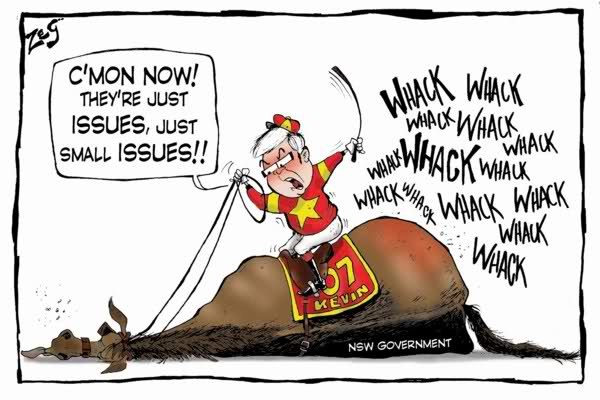The Dead Horse Theory of Management
The Dead Horse Theory of Management
Dr. Abdulrahman ALJAMOUS
There is an old Dakota tribal wisdom, which was passed over from generation to generation. It basically goes like this:
 However, in modern business far more advanced strategies are often employed, such as:
However, in modern business far more advanced strategies are often employed, such as:
- Buying a stronger whip.
- Changing riders.
- Threatening the horse with termination.
- Appointing a committee to study the horse.
- Arranging to visit other countries to see how others ride dead horses.
- Lowering the standards so that dead horses can be included.
- Re-classifying the dead horse as ‘living-impaired’.
- Hiring outside contractors to ride the dead horse.
- Harnessing several dead horses together to increase the speed.
- Providing additional funding and/or training to increase the dead horse’s performance.
- Doing a productivity study to see if lighter riders would improve the dead horse’s performance.
- Declaring that as the dead horse does not have to be fed, it is less costly, carries lower overhead and, therefore, contributes substantially more to the bottom line of the economy than do some other horses.
- Re-writing the expected performance requirements for all horses.
- Promoting the dead horse to a supervisory position of hiring another horse.
This is essentially Principle 5 of Toyota's 14 Management Principles, which states: "Build a Culture of stopping to fix problems, to get Quality right first time"
Unfortunately, this mindset is not found in a lot of organisations, with 'Management by Adrenaline' being the preferred approach and rewards and recognition being given to those who solve issues (in the short-term) through 'Heroic Activity'. Some of the symptoms of this will be:
- An incoherent vision for the department / group.
- Team Members working significant over-time in both the evenings and week-ends, not as the exception but as the rule.
- Excessive email over-load, with the expectation of immediate response.
- Multiple long, ineffective meetings; with late arrivals, missing attendees and poor actionable follow-up.
- A culture of blame and scape-goating.
- Constant fire-fighting.

This is a deleterious cycle of ineffectiveness and it takes a real recognition and commitment to change by the leadership, including role modelling of the right behaviours. However, it is difficult to do as it requires Leaders to lift themselves above the day-to-day operational mire and adopt a significantly different style of leadership.
It looks like we’re dealing with an exasperating mix of groupthink, wilful blindness and wishful thinking. Something is keeping people from doing the obvious, from dismounting the dead horse, from abandoning the lost cause. On top of that, there are no mechanisms such as institutionalised devil’s advocacy that prevented it from happening. Let’s brainstorm a few reasons why:
- Know-How: The will to dismount is there, but nobody knows how and what mode of transportation to take instead because the organisation has reached peak Peter Principle.
- Responsibility: It’s not anyone’s call to issue the death certificate and arrange the funeral. Instead, they might be engaged in an eternal game of buck-passing.
- Vested Interest: Whoever could make the call profits from a dead horse.
- Investment: Similarly, there may be too much financial or emotional investment at stake.
- Ego: As a result, the reputational damage of abandoning the dead horse is too high. Withdrawing gracefully feels impossible.
Whatever it is, living an awkward lie seems to be preferable to the group over admitting the nag should be buried six feet under. That puts the righteous and principled individual in a bind. On the one hand, you don’t want to pour fuel into the fire of collective delusion. On the other hand, dismounting and abandoning your post might not be your preferred course of action either. So the question is: How should you conduct yourself if quitting is not an option?
